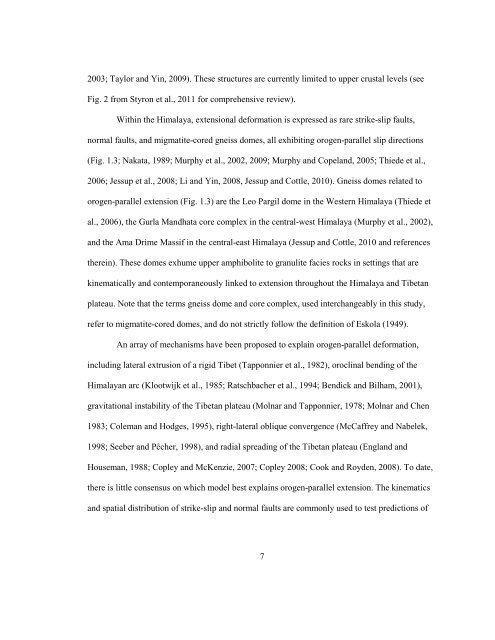title of the thesis - Department of Geology - Queen's University
title of the thesis - Department of Geology - Queen's University
title of the thesis - Department of Geology - Queen's University
Create successful ePaper yourself
Turn your PDF publications into a flip-book with our unique Google optimized e-Paper software.
2003; Taylor and Yin, 2009). These structures are currently limited to upper crustal levels (see<br />
Fig. 2 from Styron et al., 2011 for comprehensive review).<br />
Within <strong>the</strong> Himalaya, extensional deformation is expressed as rare strike-slip faults,<br />
normal faults, and migmatite-cored gneiss domes, all exhibiting orogen-parallel slip directions<br />
(Fig. 1.3; Nakata, 1989; Murphy et al., 2002, 2009; Murphy and Copeland, 2005; Thiede et al.,<br />
2006; Jessup et al., 2008; Li and Yin, 2008, Jessup and Cottle, 2010). Gneiss domes related to<br />
orogen-parallel extension (Fig. 1.3) are <strong>the</strong> Leo Pargil dome in <strong>the</strong> Western Himalaya (Thiede et<br />
al., 2006), <strong>the</strong> Gurla Mandhata core complex in <strong>the</strong> central-west Himalaya (Murphy et al., 2002),<br />
and <strong>the</strong> Ama Drime Massif in <strong>the</strong> central-east Himalaya (Jessup and Cottle, 2010 and references<br />
<strong>the</strong>rein). These domes exhume upper amphibolite to granulite facies rocks in settings that are<br />
kinematically and contemporaneously linked to extension throughout <strong>the</strong> Himalaya and Tibetan<br />
plateau. Note that <strong>the</strong> terms gneiss dome and core complex, used interchangeably in this study,<br />
refer to migmatite-cored domes, and do not strictly follow <strong>the</strong> definition <strong>of</strong> Eskola (1949).<br />
An array <strong>of</strong> mechanisms have been proposed to explain orogen-parallel deformation,<br />
including lateral extrusion <strong>of</strong> a rigid Tibet (Tapponnier et al., 1982), oroclinal bending <strong>of</strong> <strong>the</strong><br />
Himalayan arc (Klootwijk et al., 1985; Ratschbacher et al., 1994; Bendick and Bilham, 2001),<br />
gravitational instability <strong>of</strong> <strong>the</strong> Tibetan plateau (Molnar and Tapponnier, 1978; Molnar and Chen<br />
1983; Coleman and Hodges, 1995), right-lateral oblique convergence (McCaffrey and Nabelek,<br />
1998; Seeber and Pêcher, 1998), and radial spreading <strong>of</strong> <strong>the</strong> Tibetan plateau (England and<br />
Houseman, 1988; Copley and McKenzie, 2007; Copley 2008; Cook and Royden, 2008). To date,<br />
<strong>the</strong>re is little consensus on which model best explains orogen-parallel extension. The kinematics<br />
and spatial distribution <strong>of</strong> strike-slip and normal faults are commonly used to test predictions <strong>of</strong><br />
7

















